
The flag of Hong Kong, officially the regional flag of the Hong Kong Special Administrative Region of the People's Republic of China, depicts a white stylised five-petal Hong Kong orchid tree flower in the centre of a Chinese red field. Its original design was unveiled on 4 April 1990 at the Third Session of the Seventh National People's Congress. The current design was approved on 10 August 1996 at the Fourth Plenum of the Preparatory Committee of the Hong Kong Special Administrative Region. The precise use of the flag is regulated by laws passed by the 58th executive meeting of the State Council held in Beijing. The design of the flag is enshrined in Hong Kong's Basic Law, the territory's constitutional document, and regulations regarding the use, prohibition of use, desecration, and manufacture of the flag are stated in the Regional Flag and Regional Emblem Ordinance. The flag of Hong Kong was officially adopted and hoisted on 1 July 1997, during the handover ceremony marking the transfer of sovereignty from the United Kingdom back to China.

The coat of arms of Bosnia and Herzegovina was adopted in 1998, replacing the previous design that had been in use since 1992 when Bosnia and Herzegovina gained independence. It follows the design of the national flag. The three pointed shield is used to symbolize the three major ethnic groups of Bosnia, as well as allude to the shape of the country.

The flag of the Dominican Republic represents the Dominican Republic and, together with the coat of arms and the national anthem, has the status of a national symbol. The blue on the flag stands for liberty, the white for salvation, and the red for the blood of heroes. The civil flag follows the same design, but without the charge in the center. The flag was designed by Juan Pablo Duarte.
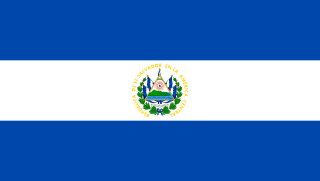
The flag of El Salvador features a horizontal triband of cobalt blue-white-cobalt blue, with the coat of arms centered and entirely contained within the central white stripe. This design of a triband of blue-white-blue is commonly used among Central American countries. Along with Bolivia, Costa Rica, the Dominican Republic, Ecuador, Haiti, and Venezuela, it is one of only seven national flags which has a depiction of its flag within the flag itself.
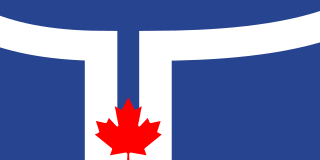
The flag of Toronto, Ontario, Canada, was originally designed in 1974 by Renato De Santis, a 21-year-old graphic design student at George Brown College. The design was the winner of a 1974 competition held by the City of Toronto Flag Design Committee. The previous flag had consisted of the city's coat of arms on a white and blue background, which was considered to be overly simplistic by then mayor William Dennison.

The Blue Sky with a White Sun serves as the design for the party flag and emblem of the Kuomintang (KMT), the canton of the flag of the Republic of China, the national emblem of the Republic of China, and as the naval jack of the ROC Navy.
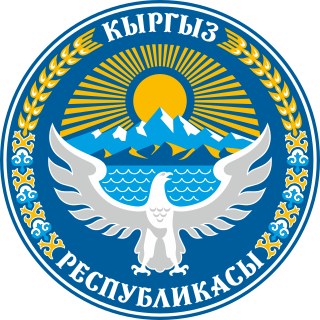
The emblem of Kyrgyzstan was adopted on 2016. The emblem has a circular form which mostly bears the color blue. Light blue is known as the Kyrgyz color of courage and generosity. To the left and right of the coat of arms, wheat and cotton are displayed. In the upper part, the name of the country appears in Kyrgyz "Кыргыз Республикасы". It was designed by A. Abdraev and S. Dubanaev.

The coat of arms of Ireland is blazoned as Azure a harp Or, stringed Argent. These arms have long been Ireland's heraldic emblem. References to them as being the arms of the king of Ireland can be found as early as the 13th century. These arms were adopted by Henry VIII of England when he ended the period of Lordship of Ireland and declared Ireland to be a kingdom again in 1541. When the crowns of England, Scotland and Ireland were united in 1603, they were integrated into the unified royal coat of arms of kingdoms of England, Scotland and Ireland. The harp was adopted as the emblem of the Irish Free State when it separated from the United Kingdom in 1922. They were registered as the arms of Ireland with the Chief Herald of Ireland on 9 November 1945.

A cross pattée is a type of Christian cross with arms that are narrow at the centre, and often flared in a curve or straight line shape, to be broader at the perimeter. The form appears very early in medieval art; for example in a metalwork treasure binding given to Monza Cathedral by Queen Theodelinda, and the 8th-century lower cover of the Lindau Gospels in the Morgan Library. An early English example from the start of the age of heraldry proper is found in the arms of Baron Berkeley.

The Regional Emblem of the Hong Kong Special Administrative Region of the People's Republic of China came into use on 1 July 1997, after the transfer of the sovereignty of Hong Kong from the United Kingdom to the People's Republic of China.
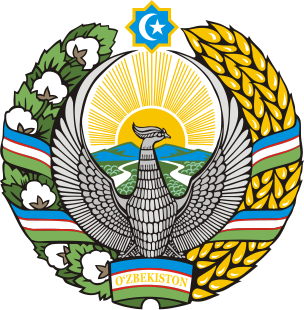
The state emblem of Uzbekistan was formally adopted on July 2, 1992 by the newly establish Republic of Uzbekistan. It bears many similarities to the emblem of the previous Uzbek SSR, which Republic of Uzbekistan succeeded. Like other post-Soviet republics whose symbols do not predate the October Revolution, the current emblem retains some components of the Soviet one. Prior to 1992, Uzbekistan had an emblem similar to all other Soviet Republics, with standard communist emblems and insignia.

This gallery of flags of federal subjects of Russia shows the flags of the 85 federal subjects of Russia.

The flag of Crimea is the flag of the Autonomous Republic of Crimea claimed by Ukraine and the Republic of Crimea claimed by Russia. The flag was officially adopted on 24 September 1992 as the flag of the Autonomous Republic of Crimea, readopted on 21 April 1999, then readopted on 4 June 2014 as the flag of the Republic of Crimea, annexed by Russian Federation.
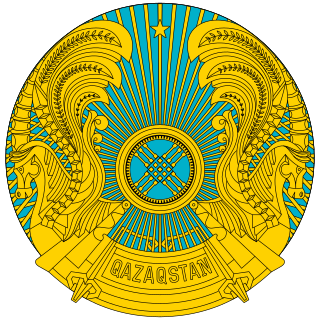
The emblem of Kazakhstan was adopted on June 4, 1992. The designers of the emblem are Jandarbek Melibekov and Shota Walikhanov. About 245 projects and 67 description designs of the future arms took part in the final competition. Like other post-Soviet republics whose symbols do not predate the October Revolution, the current emblem retains some components of the Soviet one, in this case, rising sun rays and star. Prior to 1992, Kazakhstan had an emblem similar to all other Soviet Republics.

The coat of arms of Ossetia is a red disc featuring a Caucasian leopard with seven white mountains in the background. The mountains symbolize the Ossetian landscape, while the leopard is an iconic inhabitant of the Caucasus mountains.
Upon the independence of Belarus from the Soviet Union, the country resurrected national symbols that were used before the Soviet era. These included a flag of red and white stripes and a coat of arms consisting of a charging knight on horseback. These national symbols were replaced by Soviet-era symbols in a disputed 1995 vote. Those two symbols, along with the national anthem, are the constitutionally defined national symbols of Belarus.

The flag of Kamchatka Krai, in the Russian Federation, is a horizontal bicolour of white and blue charged with an emblem. The emblem is a modification of the Coat of arms of Kamchatka Krai: three snow-capped volcano peaks on the backdrop of a red sun framed by an ornament.

The flag of Perm Krai of Russia is a rectangular panel divided by a white cross, which is the St. George's Cross of the patron of Russia, charged with the coat of arms of the krai in the centre. The corners of the panel are divided into two colours: red at the top-left and bottom-right, and blue at the top-right and bottom-left. The flag was, until 2004, the flag of the Perm Oblast, which was merged with Komi-Permyak Autonomous Okrug to form Perm Krai.

The flag of Altai Krai, in the Russian Federation, is a vertical bicolor of light-blue and red charged with a spike of wheat on the blue band and the arms of the krai on the red band. The design follows the pattern of the flags of the Russian SFSR. This center design on the flag is the coat of arms of Altai Krai. The coat of arms was adopted on May 25, 2000. The flag was adopted on June 29, 2000 during a session of the Altai Krai Council of People's Deputies.
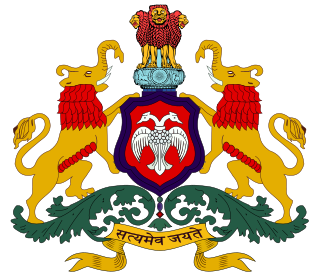
The Emblem of Karnataka is the state emblem of Karnataka, India. The emblem is based on that of the Kingdom of Mysore and the Coat of Arms of the United Kingdom and is carried on all official correspondences made by the Government of Karnataka.



















